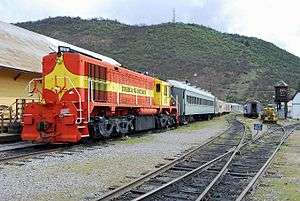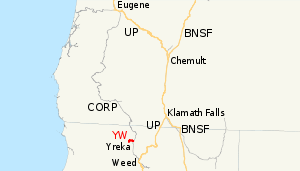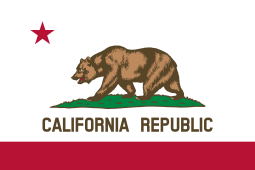Yreka Western Railroad
| Yreka Western Railroad | |
|---|---|
| Blue Goose | |
 | |
| An ALCO MRS-1 at Yreka station. | |
 | |
| Commercial operations | |
| Original gauge | 4 ft 8 1⁄2 in (1,435 mm) standard gauge |
| Preserved operations | |
| Owned by | Rocky Mountain Railroad & Mining Museum |
| Operated by | Rocky Mountain Railroad & Mining Museum |
| Reporting mark | YWRR |
| Length | 8.86-mile (14.26 km) |
| Preserved gauge | 4 ft 8 1⁄2 in (1,435 mm) standard gauge |
| Commercial history | |
| Opened | 1889 |
| 1888 | Yreka Railroad Incorporated |
| 1889 | Opened |
| 1933 | Re-Incorporated as Yreka Western Railroad |
| 1953 | Kyle Railways |
| Preservation history | |
| 1986 | Blue Goose Excursion Train Begins |
| Headquarters | Yreka, California |
The Yreka Western Railroad (reporting mark YWRR) was a shortline railroad operating freight and tourist trains between the Central Oregon and Pacific Railroad interchange at Montague and the city of Yreka, California.[1] The railroad ceased operation.[2]
The Yreka Railroad was incorporated in May 1888, with a capital stock of $100,000, and opened in January 1889, connecting Yreka to the Southern Pacific Company lessor Central Pacific Railroad (ex-California and Oregon Railroad). The decision to build the Yreka Railroad was due in part to the Central Pacific's decision to bypass Yreka in favor of a shorter, and more level route through the Shasta Valley and the city of Montague. Not to be left without a rail connection, the citizens of Yreka formed their own railroad. The railroad hauled passengers and local freight. In August 1933, the railroad was re-incorporated as the Yreka Western Railroad. The railroad was acquired by Willis Kyle in 1953 who eventually formed the Kyle Railways empire. Eventually, the Central Oregon and Pacific Railroad acquired the SP connection at Montague in 1995. in 1999 Kyle Railways sold the Yreka Western to the Rocky Mountain Railway and Mining Museum of Denver, Colorado, who owns and operates the railroad to this day.
Operations
In recent years, the railroad was operated by The Rocky Mountain Railway and Mining Museum of Denver, Colorado and provides freight service and offers passenger train excursions. The freight traffic is primarily wood chips and forest products, as well as occasional carloads of propane. The railroad also offers excursion train pulled by steam and diesel locomotives.
In 1986 the YW started operating a steam passenger train excursion known as the "Blue Goose" between Yreka and Montague. The "Blue Goose" continues to operate to this day. The railroad offers scenic views of Mount Shasta, the Shasta Valley and the Siskiyou Mountains. The trip takes about one hour in either direction, with a 60 layover in Montague for lunch. While passengers explore and eat in Montague, the crew takes the train to perform a runaround move so the locomotive will pull the train back to Yreka.
The most famous locomotive on the line is 2-8-2 Baldwin 90 ton logging mikado #19. #19 is nicknamed "Pancho" due to its time spent in Mexico in the 1920s and possible squabble with the Mexican revolutionary Pancho Villa. #19 has starred in many movies, the two most famous being "Emperor of the North" and "Stand By Me". She was built in 1915 by Baldwin for the Caddow River Lumber Company in Arkansas. She served there until being sent to Mexico in 1920 where she is believed to have been converted to oil. In 1924 she was purchased by the McCloud River Railroad. She served many years there hauling log trains until being sold to the Yreka Western Railroad in 1953. On September 19, 2016, it was announced that #19 would be up for sale in an upcoming auction and on October 6, 2016, was purchased by the Age of Steam Roundhouse.
Other locomotives include an SW8 #21 (Former Southern Pacific #1115). #21 is usually used in freight service, but is occasionally put into excursion service when the #19 needs repairs. #21 is unique because it has dynamic brakes, not usually found on switching locomotives.
See also
References
External links
| Wikimedia Commons has media related to Yreka Western Railroad. |

